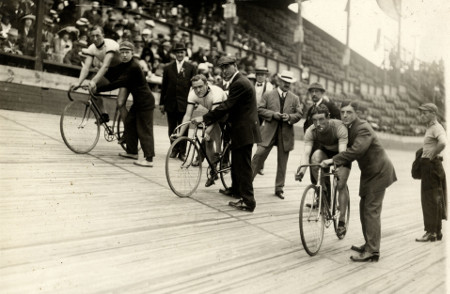mshafer62
PR Addict
Many, many, moons ago Columbus was the home to a board track. Located approximately at
the southern edge of Upper Arlington and the northern edge of Grandview...who knew?

This postcard, from the Columbus Public Library collection was mailed from Columbus to a couple in Greenville in January 1913. The image depicts the Columbus Motordrome, which was built and opened in July 1912 by the Columbus Motordrome Co. An article in the 1912 Motor World magazine contained an entry that the Columbus Motordrome Co. was established in April 1912 with $20,000 capital by William Snyder, George Baughem, Philip Vogel and others after they were approached by famous Chicago bicyclist and racetrack architect Jack Prince.
According to an article titled “Pioneers of American Motorcycle Racing” by Daniel K. Statnekov, “Prince's motordrome designs were mostly ‘seat-of-the-pants,’ an expansion of his earlier sketches for bicycle velodromes, rather than formal construction drawings. The dapper Englishman, wearing his trademark Derby hat, would walk around the site, driving stakes into the ground to mark the layout for the new track. In a grand manner, the board track impresario would hire hundreds of carpenters, and schedule railroad car deliveries of millions of board feet of lumber and tons of steel spikes.”
The Columbus Motordrome was built entirely of wood in just a few months on the site of the Arlington Gun Club, near Fifth Avenue and Cambridge Boulevard and could hold up to 5,000 fans of high-speed motorcycle racing in grandstand seats.
The enclosed green space, accessible by a tunnel under the track, could accommodate up to 1400 automobiles, or reportedly up to 100,000 fans. Motorcycles could reach speeds of over 90 mph on these short (quarter- to third-mile) banked tracks. The Arlington track closed in 1913 after a fiery motordrome crash in Cincinnati killed a racer and nine spectators and injured 35 more on a similar 30-degree banked track. The accident caused these short-track facilities to be referred to as “murderdromes” because of the number of fatalities across the country, and most were closed over the following several years. Subsequent tracks were longer and included advanced safety innovations.
This historical narrative from the Grandview Heights/Marble Cliff Historical Society was provided by Wayne Carlson.
the southern edge of Upper Arlington and the northern edge of Grandview...who knew?
This postcard, from the Columbus Public Library collection was mailed from Columbus to a couple in Greenville in January 1913. The image depicts the Columbus Motordrome, which was built and opened in July 1912 by the Columbus Motordrome Co. An article in the 1912 Motor World magazine contained an entry that the Columbus Motordrome Co. was established in April 1912 with $20,000 capital by William Snyder, George Baughem, Philip Vogel and others after they were approached by famous Chicago bicyclist and racetrack architect Jack Prince.
According to an article titled “Pioneers of American Motorcycle Racing” by Daniel K. Statnekov, “Prince's motordrome designs were mostly ‘seat-of-the-pants,’ an expansion of his earlier sketches for bicycle velodromes, rather than formal construction drawings. The dapper Englishman, wearing his trademark Derby hat, would walk around the site, driving stakes into the ground to mark the layout for the new track. In a grand manner, the board track impresario would hire hundreds of carpenters, and schedule railroad car deliveries of millions of board feet of lumber and tons of steel spikes.”
The Columbus Motordrome was built entirely of wood in just a few months on the site of the Arlington Gun Club, near Fifth Avenue and Cambridge Boulevard and could hold up to 5,000 fans of high-speed motorcycle racing in grandstand seats.
The enclosed green space, accessible by a tunnel under the track, could accommodate up to 1400 automobiles, or reportedly up to 100,000 fans. Motorcycles could reach speeds of over 90 mph on these short (quarter- to third-mile) banked tracks. The Arlington track closed in 1913 after a fiery motordrome crash in Cincinnati killed a racer and nine spectators and injured 35 more on a similar 30-degree banked track. The accident caused these short-track facilities to be referred to as “murderdromes” because of the number of fatalities across the country, and most were closed over the following several years. Subsequent tracks were longer and included advanced safety innovations.
This historical narrative from the Grandview Heights/Marble Cliff Historical Society was provided by Wayne Carlson.

